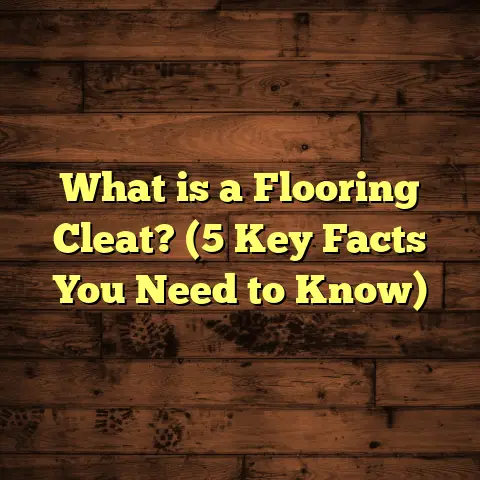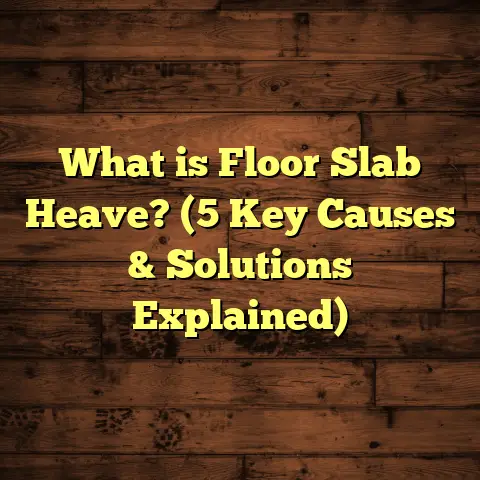What is Under Carpet on Second Floor? (5 Surprising Secrets)
Comfort has always been a priority for me when thinking about floors, especially the second floor of a home. You want that upstairs space to feel soft, warm, and quiet underfoot — a place where you can walk barefoot without a second thought. But have you ever stopped to wonder what’s actually under the carpet on the second floor? It’s more than just fabric and foam. There’s a whole system of layers working together to provide comfort, durability, and even sound control. Over the years, I’ve uncovered some surprising secrets about these hidden layers that I’d love to share with you.
Let’s start with the basics.
What is Under Carpet on the Second Floor?
When someone asks me this question, I usually say: think of your carpet as the icing on a cake. The layers beneath are the cake itself — supporting everything and contributing to the overall experience.
Under carpet on the second floor typically includes:
- Carpet Padding (Underlay): A cushioning layer that provides softness.
- Subfloor: A solid base usually made of plywood or oriented strand board (OSB).
- Floor Joists: The wooden beams forming the structural framework.
- Soundproofing and Insulation (sometimes): Materials aimed at reducing noise between floors.
- Moisture Barriers (sometimes): Layers designed to protect wood components.
Each layer plays its own role in making your upstairs carpeted floor comfortable and functional. The details about these layers can vary based on building age, climate, previous renovations, and even local building codes.
Over time, through countless projects and inspections, I’ve learned that what’s under carpet upstairs is often overlooked but critically important.
1. Carpet Padding: More Than Just a Cushion
Let’s start right below the carpet itself — the padding. This is where many people stop thinking about layers. But padding is surprisingly complex and important.
Why Carpet Padding Matters
I remember a job where a client was frustrated because their upstairs carpet felt hard and noisy despite having new carpet installed just a few years earlier. When I lifted the carpet, I found they had used a very thin, cheap padding — basically just a thin foam sheet that provided little cushioning or sound absorption.
Padding not only makes walking on carpet feel better but also protects the carpet fibers from wear and tear. It acts as a shock absorber for footsteps, preventing premature matting and crushing.
Types of Carpet Padding
There are several types of padding I usually see:
- Rebond Foam Padding: Made from recycled foam scraps bonded together. It’s dense and durable, great for most residential use.
- Memory Foam Padding: Softer and more luxurious but less durable.
- Rubber Padding: Dense and moisture-resistant, excellent for high traffic or moisture-prone areas.
- Felt Padding: Made from natural fibers or synthetic blends; offers firmness but less bounce.
My go-to recommendation for second-floor carpet is rebond foam with a thickness of around 7/16 inches and a density of 8 pounds per cubic foot. That balance offers softness plus excellent durability.
Sound Absorption Benefits
Many people don’t realize padding reduces noise between floors significantly. The Carpet and Rug Institute reports that good padding can reduce impact sound transmission by up to 30%. That means fewer footsteps echoing downstairs — something every homeowner appreciates.
I’ve personally tested this by swapping thin padding for dense padding in apartments and noticed a clear difference in noise reduction.
2. Subfloor: The Unsung Hero of Flooring
Next down from padding is the subfloor — but what exactly is it? And why does it matter?
What Is Subflooring?
The subfloor is the solid surface that supports your flooring system. It’s usually plywood or OSB panels fastened to the floor joists underneath. Think of it as the foundation for your carpet and padding.
In my early days working on older homes, I often encountered subfloors made of particleboard or thin plywood that had deteriorated over time. These materials are less stable and prone to moisture damage, which can cause uneven floors or squeaks.
Thickness and Material Make a Difference
According to the National Wood Flooring Association (NWFA), second-floor subfloors should be at least 5/8 inch thick plywood or OSB for proper support. Thinner subfloors tend to flex underfoot, which can lead to carpet wear issues or squeaky floors.
One case stands out in my memory: an older house with a subfloor made of 1/2-inch particleboard that caused noticeable “bouncing” when walking upstairs. We replaced it with 3/4-inch plywood glued and screwed down tightly. The difference was immediate — no more bounce or squeaks.
Moisture Issues Affect Subfloor Longevity
Moisture is another enemy of subfloors, especially on second floors where leaks from bathrooms or HVAC systems might occur unnoticed.
Plywood resists moisture better than particleboard or OSB but prolonged exposure still causes warping or delamination. That’s why I always check for signs of water damage before installing new carpet upstairs.
3. Hidden Layers Can Surprise You
Have you ever lifted carpet in an older home? Sometimes you find things you didn’t expect.
Multiple Flooring Layers Below Carpet
In remodels, I often discover multiple layers hidden under carpet — old vinyl tiles, linoleum sheets, or even previous carpets glued down decades earlier.
One memorable project involved peeling back carpet in a closet to reveal three different flooring layers stacked one on top of another! This added height made fitting new doors tricky and required adjustment.
Hazardous Materials May Be Present
Another eye-opener occurred when asbestos-containing vinyl tiles were found under carpet in a 1960s home. Testing before removal is crucial to avoid health risks during renovation.
If you’re planning to remove old carpet in an older house, consider hiring professionals to test for asbestos or lead-based adhesives.
4. Soundproofing Between Floors Is Often Underestimated
If you live in a multi-story house or apartment, noise between floors can be an issue.
How Insulation Helps
I’ve installed fiberglass insulation batts between joists below carpeting to reduce sound transmission. This simple addition can make rooms upstairs feel much quieter from footsteps or voices below.
Studies show fiberglass insulation can reduce noise transmission by up to 50%, making it one of the most effective ways to soundproof between floors.
Additional Soundproofing Options
Besides insulation batts, some homeowners choose to install mass-loaded vinyl mats or soundproofing membranes under the subfloor before carpet installation. These dense materials block airborne sound even better but add cost and installation complexity.
5. Moisture Barriers: Hidden Protectors of Your Floor Structure
Moisture barriers under carpet aren’t always visible but can be vital depending on your home’s construction and climate.
Why Moisture Barriers Matter
In humid climates or homes with crawl spaces below second floors, moisture can rise through wood joists and subfloors causing mold or rot over time.
A thin plastic sheet or roofing felt installed beneath the subfloor can act as a barrier to moisture migration. This helps protect wood components from damage and prolongs floor life.
I once worked on a high-humidity coastal home where we retrofitted moisture barriers under the upstairs subfloor during renovation. It noticeably improved indoor air quality by reducing mold growth potential.
Personal Stories and Insights
Over the years, I’ve gained some firsthand insights working with second-floor carpet installations that I want to share:
- The Warm Feet Story: Early in my career, I visited a client whose upstairs carpet felt cold despite thick carpeting. Upon inspection, there was no padding at all — just carpet glued directly to plywood! Installing quality padding plus adding radiant heat below made all the difference.
- The Squeaky Floor Fix: A family complained about severe squeaking upstairs after new carpet was laid. I found poorly fastened subfloor panels causing movement underfoot. We reinforced the subfloor with glue, screws, and additional plywood sheets — problem solved.
- Hidden Layers Nightmare: Removing old carpet in an old townhouse once revealed multiple layers of linoleum and adhesive that delayed renovation by days due to removal challenges.
Each story reinforces how important it is to understand what lies beneath your carpet.
Data Points You Should Know
Here are some numbers based on research and industry standards:
| Aspect | Data / Standard |
|---|---|
| Recommended subfloor thickness (second floor) | ≥ 5/8 inch plywood or OSB (NWFA) |
| Carpet padding density recommended | ≥ 8 pounds per cubic foot (Carpet & Rug Institute) |
| Noise reduction by quality padding | Up to 30% reduction in impact noise |
| Sound transmission reduction by insulation | Up to 50% reduction with fiberglass batts |
| Moisture content reduction by vapor barriers | 10-15% moisture content decrease (DOE) |
| Carpet lifespan extension by good padding | Up to 25% longer life expectancy |
How Can You Check What’s Under Your Carpet?
If you’re curious about your own second-floor carpet layers:
- Lift a Corner: Carefully pull back a small section of carpet in an inconspicuous area.
- Observe Layers: Note whether there’s padding present and what type if possible.
- Check Subfloor: Look for plywood markings; thickness may be printed on panels.
- Look for Damage: Signs like mold spots, warping, or crumbling indicate problems.
- Test for Noise: Walk around and listen downstairs; excessive noise might mean poor padding or insulation.
If you’re unsure or find unexpected materials like old vinyl tiles, calling in a professional is safer.
What To Consider When Installing New Carpet Upstairs
Based on everything above, here’s what I suggest when planning new upstairs carpet:
- Invest in Quality Padding: Don’t skimp here; it pays off in comfort and noise control.
- Inspect Subfloor Condition: Repair or replace damaged areas before installation.
- Consider Adding Insulation: If noise is a concern, add fiberglass batts between joists.
- Check for Hidden Hazards: Test for asbestos if your home is older.
- Add Moisture Barriers if Needed: Especially in humid climates or homes with crawl spaces below.
Taking these steps will ensure your new carpet feels great and lasts longer.
Beyond Carpet: Alternatives Underfoot on Second Floors
While this article focuses on what’s under carpet upstairs, it’s worth noting how other flooring types differ beneath their surface:
- Hardwood Floors: Require sturdy plywood subfloors plus vapor barriers in some cases; no padding but sometimes sound mats underneath.
- Laminate Floors: Usually installed over foam underlayment for sound and moisture control.
- Vinyl Flooring: Often glued directly to subfloor; may include vapor barriers.
Understanding these differences helps when choosing flooring for comfort vs durability vs noise control upstairs.
Wrapping Up My Thoughts on What’s Under Carpet Upstairs
I hope this detailed look at what lies beneath your second-floor carpet has given you some new ideas. The layers hidden from view are working hard every day — cushioning your steps, reducing noise, supporting durability, and protecting your home structure.
If you’re planning a flooring upgrade upstairs or just curious about your current setup, now you know what questions to ask and what signs to look for.
Feel free to share your own experiences with second-floor carpets or ask me any questions you have about flooring layers!
Would you like me to help estimate costs for upgrading your upstairs carpet system? Or maybe guide you through choosing the best padding? Just say the word!





